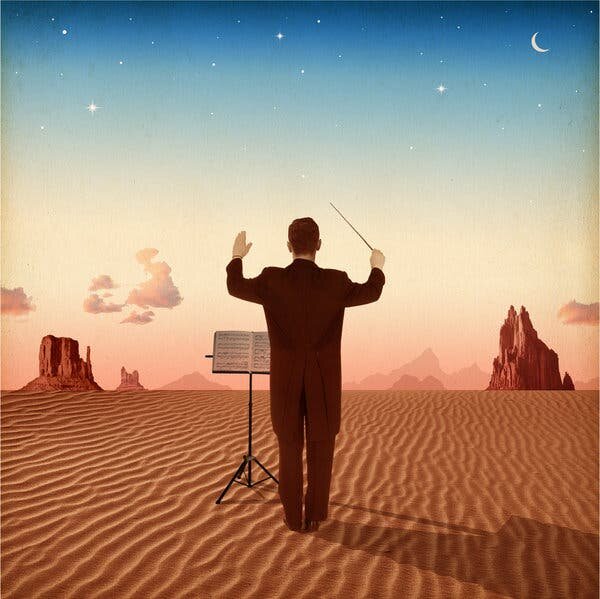By The Landlord
"Fair and softly goes far." – Miguel de Cervantes
"I praise loudly. I blame softly." – Catherine the Great
"I close my eyes, then I drift away, into the magic night I softly say. A silent prayer, like dreamers do, then I fall asleep to dream my dreams of you." – Roy Orbison
Perhaps what's audible is an intake of breath, the slide of hand or scratch of nail on fret or keys, a singer's swallowing, gentle sighing, a low hum or click of amp, air movement, the shift of foot on floor, and the feeling of a performer's tangible, physical presence. And of course those gaps, an inexorable, absorbing dance with silence. Songs that savour the spaces between notes.
So then, from pianissimo, sotto voce to whispering vocals, acoustic instruments, lo-fi, to minimalistic electro tones, gentle intimacy to a sense of slow menace, this week is not a direct repeat of last week's topic, instead, a new echo. While standing in a similar position, we change perspective, and, by popular request, move away from songs about quietness, now leaving behind all the lyrics and metaphors, and instead focus solely on the music, to turn up the volume on all pieces performed and recorded at a perceptively low level.
What constitutes a quiet song is of course entirely subjective. It's something we sense and feel. A quiet song could contain one instrument and voice, or dozens. It is entirely down to how they are performed. An entire orchestra or brass band can play a quiet piece of music. But what constitutes a quiet song is likely to include some sense of restraint or control, even though raging emotions might lie beneath.
Nor indeed are quiet songs necessarily minimal songs. Minimalistic songs could be loud, but just simple or stripped back in their composition. T Bone Burnett has dropped into the rarefied atmosphere of the Bar this week to explain why, although he has written and produced songs which one might call quiet, his preference is not for that category, but his method explains it. "I love loud music. I listen loud, and that's part of how I've learned how to do this. Record softly and play back loud and a whole other thing happens." So let’s turn those quiet songs right up.
Are there instruments then that might help define a quiet song? No instrument is entirely blunt, perhaps not even the bagpipes, as long as they are recorded at a distance. Even a church organ can be played quietly, or at least recorded and produced that way. And drums too are particularly responsive to a gentle touch, especially if the sticks are replaced by brushes.
But perhaps certain plucked stringed instruments, such as the low thrum of the double bass, an acoustic or classic guitar, harp, or zither might come up frequently, as well as their keyboards cousin, the harpsichord. One of the most beautiful in the zither family is the Chinese guqin:
Flutes and piccolos might be classed also as gentle, quiet instruments, extending a tender evocation of the voice, and also a host of acoustic, handmade instruments, from the African thumb piano, the mbira or kalimba.
Some vocalists have a distinctively quiet, intimate style. Here's Gillian Welch, explaining how she found hers: "The main thing was finding a voice that I had interest in, which I'll call the quiet-yet-stoic voice: the very quiet yet very strong voice that I developed, that people would want to hear and that was worth paying attention to."
And there are many others who deliver with a quiet weight, from Donovan to the half-talking, singing and hilariously sweary Aidan Moffat, accompanied by RM Hubbert, Smog's Bill Callahan, Joni Mitchell, Lambchop's Kurt Wagner, Nina Simone at moments of quiet menace, and more recent others who have developed a more whispery, intimate style, such as Billie Eilish, Jamie xx, or Oh Wonder's Josephine Vander Gucht and Anthony West.
Bill Callahan, who has made many albums as Smog
And then there are composers who must certainly come into this category. The quiet piano stillness of French composer Charles-Camille Saint-Saëns, the slow, glacial build of Estonia's Arvo Pärt, and then here's one starter for the topic, an exquisite piece by the Finnish composer Einojuhani Rautavaara, and his Cantus Arcticus (1972), an extraordinary evocation of the landscape of the topmost northern hemisphere, complete with bird song, giving a sense of the planet slowly turning and gently coming to life.
Last week, for the lyric-based version of quietness, I gave a few film examples, and to close, here’s just one, the preview of a new film, Silence of the Tides, directed by Pieter-Rim de Kroon of Amsterdam-based Windmill Films, about about the largest tidal wetland in the world, The Wadden Sea, an intertidal zone in the southeastern part of the North Sea. It lies between the coast of northwestern continental Europe and the range of low-lying Frisian Islands. It’s a film that quietly breathes in an out as life comes and goes on its ever changing landscape, never quite land or sea, but a still, quiet otherness of in between. Still waters may run deep, but also here, in a shallow, echoey world of beauty.
So then, taking on the other side of quietness that remains an ever more topical subject in this lockdown world, I’m delighted to welcome back for a double dose after last week’s ‘about’ version, the deftly detailed DiscoMonster! Please put your quiet songs in comments below in time for last orders on Monday evening, possibly 11pm UK time or maybe slightly earlier if it goes quiet, for playlists published on Wednesday. Sshh …
The quiet conductor
New to comment? It is quick and easy. You just need to login to Disqus once. All is explained in About/FAQs ...
Fancy a turn behind the pumps at The Song Bar? Care to choose a playlist from songs nominated and write something about it? Then feel free to contact The Song Bar here, or try the usual email address. Also please follow us social media: Song Bar Twitter, Song Bar Facebook. Song Bar YouTube. Subscribe, follow and share.
Please make any donation to help keep Song Bar running:



